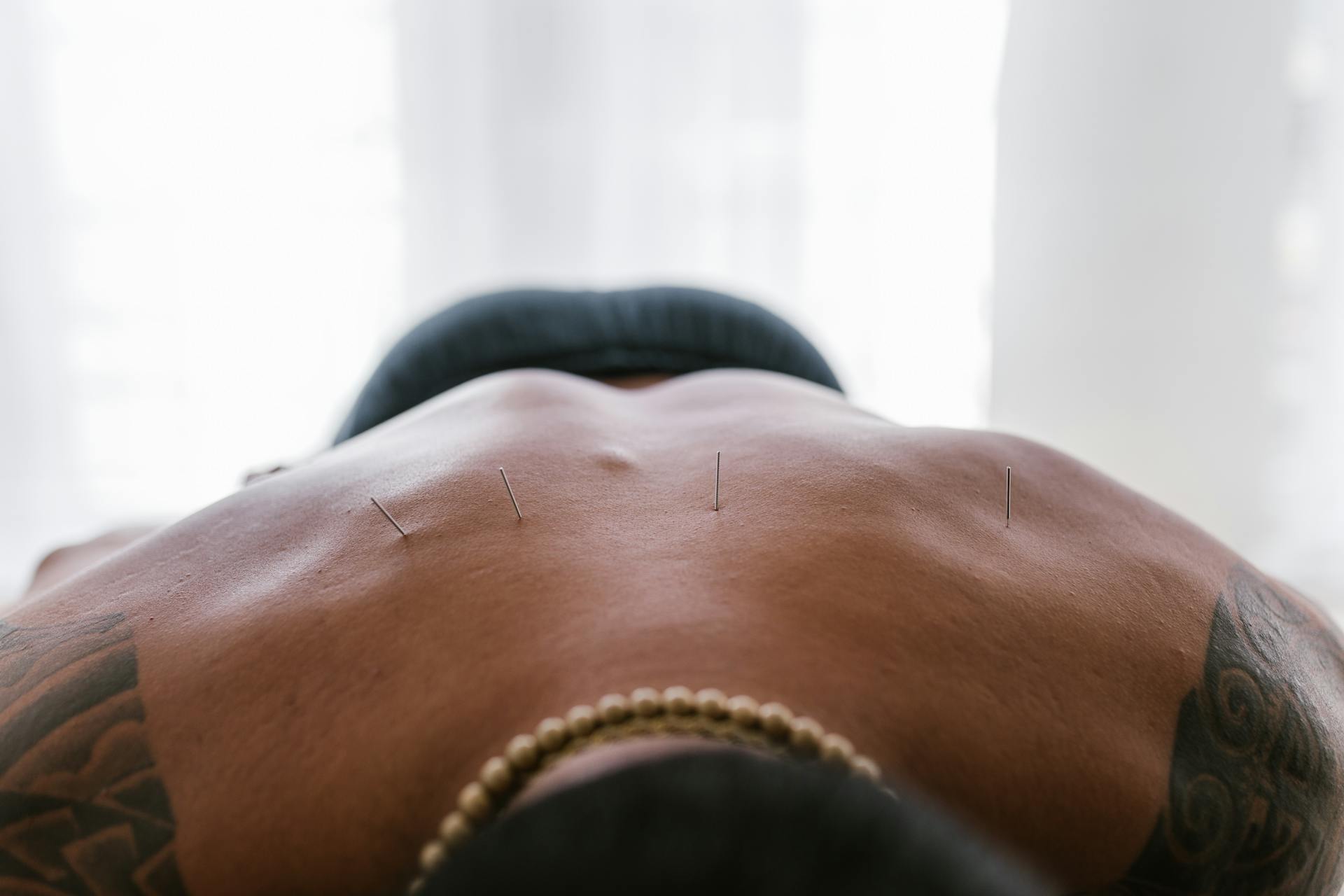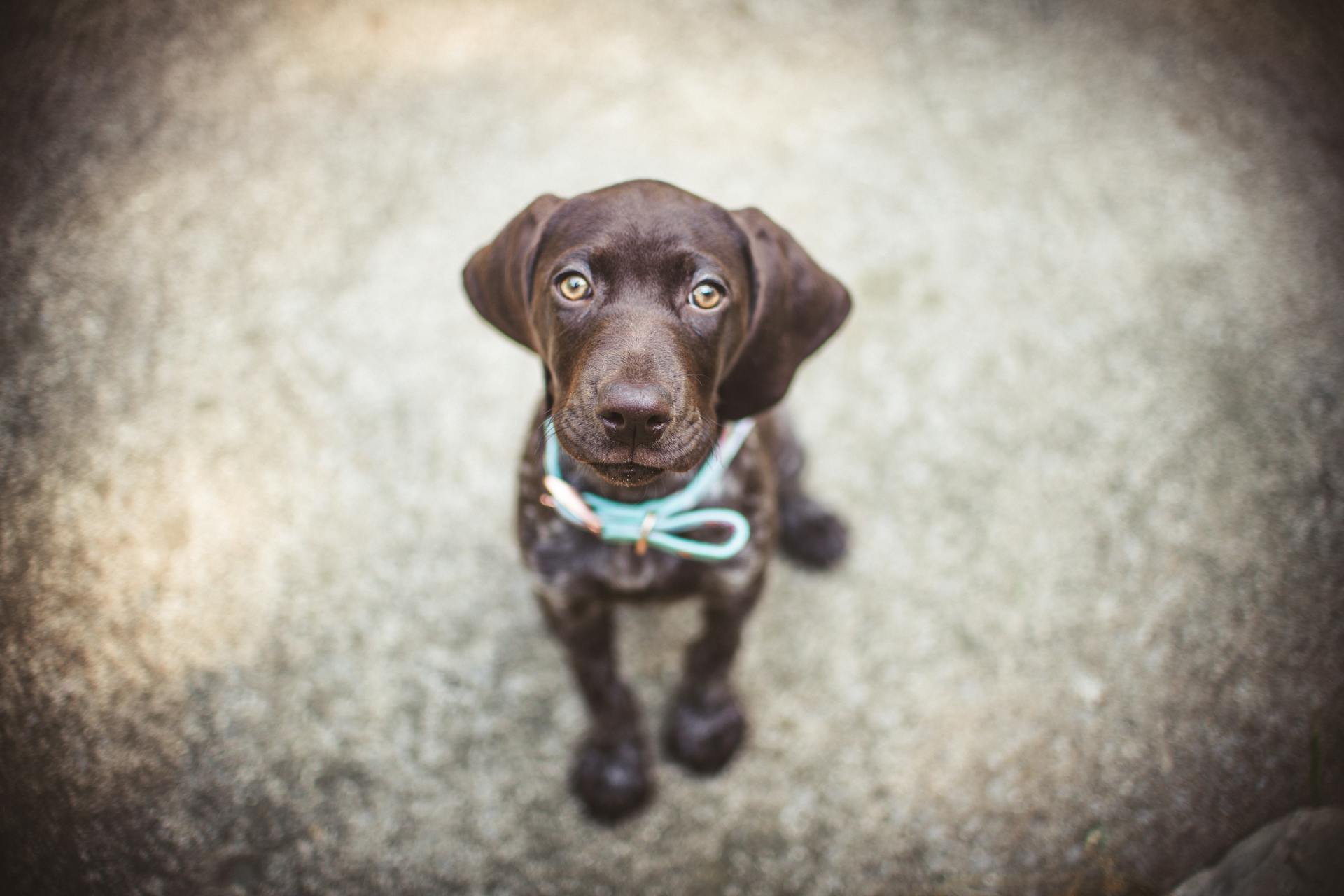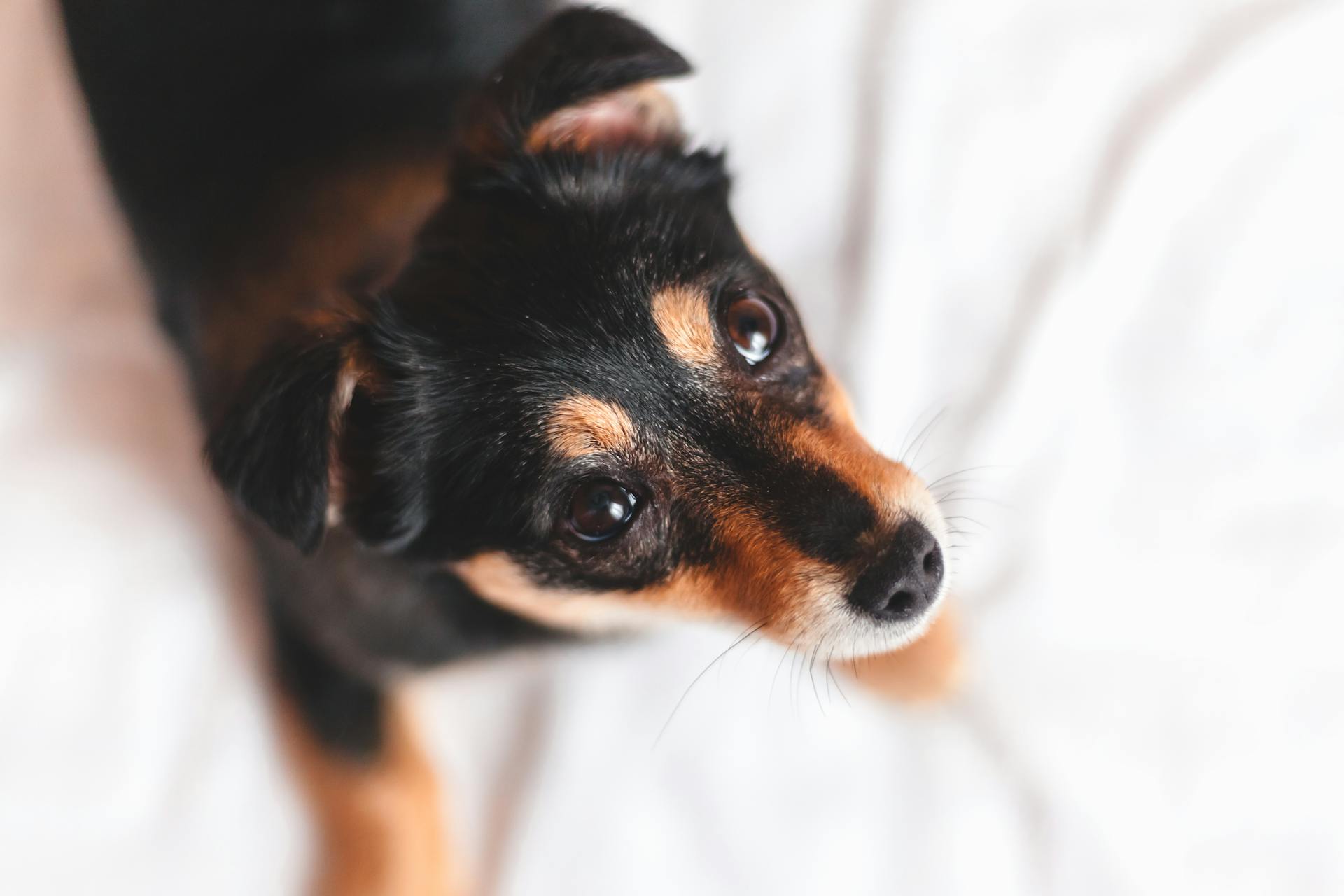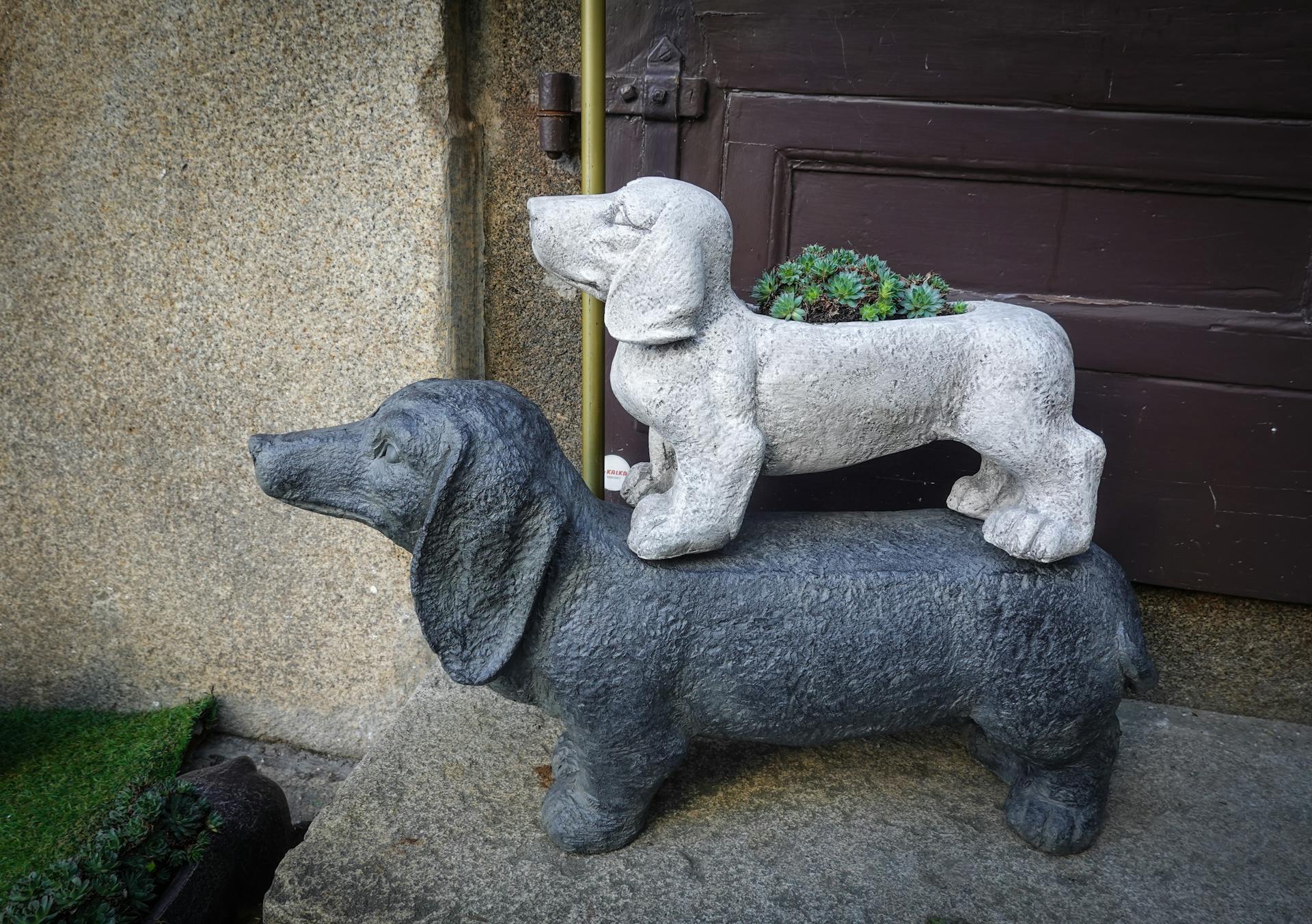
If your Dachshund has been diagnosed with Intervertebral Disc Disease (IVDD), you're likely feeling overwhelmed and unsure of what to do next. The good news is that with prompt treatment, many Dachshunds can make a full recovery.
According to research, Dachshunds are 20 times more likely to develop IVDD than other breeds, making it a serious concern for Dachshund owners. This is because of their unique body shape, which puts pressure on their spine.
The goal of treatment is to stabilize the spine, reduce pain, and prevent further injury. Your veterinarian may recommend a combination of medication, physical therapy, and surgery to achieve this.
Expand your knowledge: Ivdd in Corgis
What Is IVDD?
IVDD, short for Intervertebral Disc Disease, is a common health issue affecting many breeds, including Dachshunds.
The condition occurs when the soft, gel-like discs between the vertebrae in the spine degenerate or herniate, putting pressure on the spinal cord and nerves.
Dachshunds are particularly prone to IVDD due to their long, narrow bodies and short legs, which can cause their spines to bend and put extra pressure on the discs.
In severe cases, IVDD can lead to paralysis and incontinence, while in mild cases, it may only cause mild back pain and stiffness.
Some Dachshunds may experience a gradual onset of symptoms, while others may have a sudden and severe episode of back pain or paralysis.
Suggestion: Weiner Dog Back Brace
Treatment Options
Treatments for IVDD in Dachshunds can go one of two ways: Conservative (non-surgical) or Surgical, depending on the severity of the damage to the spinal cord.
Conservative treatment typically involves a combination of rest, pain medication, anti-inflammatory drugs, and physical therapy. In severe cases, surgery may be necessary to remove or repair damaged discs.
A Conservative Treatment Method includes anti-inflammatory medication from your vet, crate rest for 6-8 weeks, and reduction of activities.
Physical therapy and rehabilitation are crucial parts of follow-up care and rehabilitation, as managing pain is key to helping the body heal easier.
Here's a summary of some treatment options:
- Conservative Treatment (Non-Surgery): rest, pain medication, anti-inflammatory drugs, physical therapy
- Surgery: to remove or repair damaged discs
- Medications: pain relief and anti-inflammatory medication
- Physical Therapy & Rehabilitation: managing pain and helping the body heal
- Laser Therapy: reduces IVDD pain naturally and speeds up healing time
- Stem Cell Therapy: a last-resort option when conventional treatments haven't worked, which may help reduce inflammation and encourage healing
Conventional
Conventional treatments for IVDD typically involve a combination of rest, pain medication, anti-inflammatory drugs, and physical therapy. In severe cases, surgery may be necessary to remove or repair damaged discs.
Rest is a crucial part of conventional treatment, allowing the spine to heal and reducing further injury. This can involve crate rest for 6-8 weeks, as recommended by veterinarians.
Anti-inflammatory medication is often prescribed to reduce pain and inflammation. Gebapentin, for example, is a safe and effective option for nerve pain.
Pain medication and anti-inflammatory drugs can provide relief, but they may not address the underlying issue. In some cases, surgery may be necessary to repair or remove damaged discs.
Your veterinarian may recommend a combination of medications, including anti-inflammatory drugs and pain medication, to manage your dog's symptoms.
Conservative Method: (No-Surgery)
The Conservative Method: (No-Surgery) is a viable option for treating IVDD in dogs. This approach focuses on non-invasive treatments to alleviate symptoms and promote healing.
Anti-inflammatory medication from your vet is often prescribed to reduce pain and inflammation. This medication can help manage your dog's discomfort and improve their quality of life.
Crate rest for 6-8 weeks is a crucial part of the Conservative Treatment. This allows your dog's spine to heal and reduces the risk of further injury.
Reducing activities is also essential during the Conservative Treatment. This means limiting exercise and playtime to prevent putting unnecessary strain on your dog's back.
Here's a summary of the Conservative Treatment:
Phototherapy
Phototherapy is a game-changer for Dachshunds with IVDD. It provides several benefits, including pain relief through the release of endorphins.
One of the key advantages of phototherapy is its ability to reduce inflammation, which can minimize tissue damage and promote healing. This is especially important for Dachshunds with IVDD, as inflammation can exacerbate the condition.
Phototherapy can also improve mobility in pets with IVDD by alleviating pain and reducing inflammation. This can enhance a pet's overall quality of life.
Here are the benefits of phototherapy for pets with IVDD:
- Pain Relief: LED light energy stimulates the release of endorphins, providing natural pain relief.
- Reduced Inflammation: Phototherapy helps control inflammation, minimizing tissue damage and promoting healing.
- Improved Mobility: By alleviating pain and reducing inflammation, phototherapy can enhance a pet’s mobility and overall quality of life.
- Non-Invasive: Unlike surgery, phototherapy is non-invasive and safe, minimizing the risks associated with more invasive procedures.
- Accelerated Healing: Phototherapy can expedite the healing process, helping pets recover more quickly.
Phototherapy is a safe and effective treatment option for Dachshunds with IVDD, and it's worth considering as part of their treatment plan.
Prevention and Rehabilitation
Prevention is key when it comes to keeping your dachshund safe from IVDD. A strong back puts less stress on the discs themselves to absorb impacts, so keep your dog strong with regular exercise. Don't let your dog do stairs, as this can be a common cause of injury. Use ramps for couches and beds instead.
DoggoRamps, a company founded by Crusoe's family, sells dog ramps for beds and couches that can be used by small to large dogs. They've sold over 10,000 ramps and are proud to be helping make a difference for pets' lives at home.
While prevention is crucial, accidents can still happen. If your dog does experience an IVDD episode, it's essential to keep them immobile and visit your vet to assess the situation. Your vet will be able to determine if the disc is pushing on the spinal cord and recommend the best course of action.
Prevention
Prevention is key when it comes to reducing the risk of IVDD in dogs. A strong back puts less stress on the discs themselves to absorb impacts, so keeping your dog strong is essential.
To prevent injuries, it's best to avoid letting your dog do stairs. Baby gates can be set up at the top and bottom of all staircases to prevent accidents. This has been a lifesaver for many dog owners, including those with dachshunds who are prone to IVDD.
Broaden your view: How to Prevent Twisted Stomach in Dogs
Using ramps for couches and beds can also help prevent injuries. A company called DoggoRamps sells dog ramps for the bed, as well as for the couch, for small dogs to large dogs. They've even helped over 10,000 dogs avoid injury and enjoy more cuddle time with their owners.
Here are some tips on how to prevent an injury:
- Keep your dog strong!
- Don't let your dog do stairs!
- Use ramps for couches and beds.
By following these simple tips, you can reduce the risk of IVDD in your dog and help them live a happy and healthy life.
Dog Supplements
When it comes to supporting your dog's health, supplements can play a vital role.
Turmeric is a natural supplement that's recommended for dogs with IVDD, as it has anti-inflammatory properties that can help reduce pain and inflammation.
Always check with your vet before giving your dog any supplements, as they can interact with medications or have adverse effects in certain situations.
Omega-3s are another natural supplement that's beneficial for dogs with IVDD, as they help reduce inflammation and promote healing.
These supplements can be a great addition to your dog's treatment plan, but it's essential to consult with your vet to determine the best course of action for your furry friend.
Suggestion: Ivdd in Dogs Breeds
Harness
When your Dachshund needs extra support, a harness can be a game-changer. A dog support harness, like the one mentioned, gently loops under your dog, just in front of the back legs.
Using a harness, especially one designed for IVDD-friendly dogs, can provide the extra strong support your dog needs. I recommend pairing the rehab sling with the IVDD-friendly harness from DJANGO for extra strong support.
A canine orthopedic back brace, recommended by your vet, can also help your Dachshund regain their strength and sense of independence. This can be a valuable addition to your dog's recovery and prevention plan.
Expand your knowledge: Dog Harness for Mini Dachshund
Twenty-Six Comments
One reader suggested a Disc ablation procedure as a preventive measure for IVDD. This procedure is done before surgery is required.
The veterinary medicine school at Oklahoma State University can provide additional information on this procedure, which is worth looking into.
A Disc ablation procedure can be a viable option for pet owners who want to explore non-surgical solutions for IVDD.
Advanced Treatment Options
Stem Cell Therapy is an option for dogs with IVDD, but it's not widely offered or endorsed by neurologists due to its newness and unproven nature.
Stem cells can be harvested from your dog or obtained from a donor, and they have powerful anti-inflammatory and immune-modulatory properties.
The stem cells are culture-expanded in a lab and injected intrathecally under fluoroscope guidance, allowing them to flow throughout the spinal cord and potentially "home in" on damaged areas.
This treatment can encourage a pro-healing environment, particularly in chronic cases where the body has given up on healing.
Results vary, and stem cells are hard to study due to differences in individual stem cells.
Stem cells might offer some mild improvement on average, or your dog may be a non-responder, but they could also be a super-responder.
One of the reasons conventional doctors might dismiss stem cells is because they were initially thought to differentiate into neurons and regrow nerves, but this didn't happen.
Despite initial disappointment, stem cells can still have some benefit that is now largely overlooked.
Some studies are underway to explore the effectiveness of stem cell treatment for dogs with IVDD, and there are inspiring stories of dogs regaining mobility after treatment.
Frequently Asked Questions
What is the average age for a Dachshund to get IVDD?
The average age for a Dachshund to develop IVDD is typically over 4 years old. Most cases occur in older Dachshunds, with a significant increase in reports after this age.
Sources
- https://petlight.vet/ivdd/
- https://celebritydachshund.com/pages/intervertebral-disc-disease-ivdd-in-dachshunds
- https://www.ethosvet.com/blog-post/dachshund-and-intervertebral-disk-disease/
- https://www.pawsitivestepsrehab.com/blog/ivdd-a-dachshunds-tale/
- https://www.dachshundstation.com/dachshund-ivdd-therapy/
Featured Images: pexels.com


